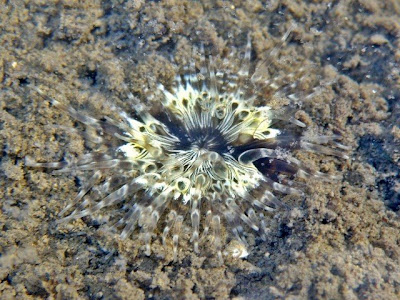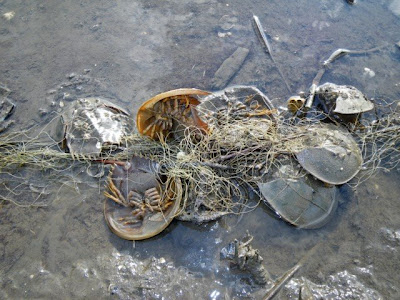Finally, I get to join the Anemone army with Dr Daphne Fautin, world expert in sea anemones! Sadly, it's also the last trip of the series but it's better than never.
Two years ago, our finale hunt was Sungei Buloh and this time also. And Dr Daphne is looking for a special mangrove anemone that she chanced upon the previous trip. And here we go, working hard to find the nems.
Ria suggested that mangrove anemones usually are found beside streams and therefore, we headed out to the different streams in search of our targets.
However, getting about in the mangrove mud is not joke at all. It's as good as aerobics that test your leg muscles.
Low and behold, we started spotting blobs in and among the mud. Those that are actually attached to hard surfaces are most likely Anthopleura handi, which Dr Daphne is not looking for in this trip.
Blobs like this that only burrow in the mud and not attached to anything are our target. There are white lines that radiate out along the body column of the anemone with some white tentacles spilling out.
They are the mangrove anemones that we are looking for in general though specifically, Dr Daphne thinks there are many kinds of this kind of anemone and thus a closer look is required.
Once in a while, we get to find some of them with most of their tentacles exposed despite being out of water.
Sometimes in the waters, their pretty tentacles can be seen.
And if we are lucky, there's chance to see the oral disk or the mouth more clearly. And there are some petal-like structures which we got to take a closer look later on.
During the first half of the trip when anemones are not too abundant, I jokingly made a statement saying that there are more horseshoe crabs than anemones! Indeed, we encountered all sorts of horseshoe crabs from extremely small ones to adult sized ones. They are really very common on our mangroves and that's definitely good news!
Following the tiny streams that led out to Johor Straits, we hit an area that is very soft!
It was here that we started seeing lots of anemone stuck onto shells of hermit crabs and living snails. The anemones are named Paraiptasia radiata.
Paraiptasia radiata have the distinguishing feature of stripes that radiate outwards from the centre along their body column.
Walking tactfully on the soft mud, I went to take a look at the low water level mark to check for any other nems but to my shock, there was a long drift net laid across the shore.
And among the drift net are many trapped horseshoe crabs. Oh no!
When we say mangroves are the root of life during conversations or guided walks, we really mean it!
Among the roots of mangrove trees are the plentiful spread of Green mussels (Perna viridis).
Buloh has surprises because it is full of Beccari's seagrass (Halophila beccarii). Globally, it is considered a rare and uncommon seagrass with a distribution restricted to the Bay of Bengal and South China Sea. Before our discovery of this seagrass at Buloh during the previous nem trip, we only know that this species exist only in small patches at Chek Jawa.
Beccari's seagrass is the smallest seagrass found on our shores (0.5cm long). The long oval-shaped leaves emerge in a rosette of 5-10 tiny leaves on long thin stems.
Soon it's time to gather back and call it a day (at least only for the field trip part)! Dr Daphne gamely demonstrates how she hunts for anemones.
Back in the museum, the true colours of the anemones were shown. Wow, how pretty they are when they are clear of mud.
And yes, we can see more clearly the petal-like structures at the mouth of the anemone. Andreas says these the structures are not inner rings of tentacles.
The Anthopleura handi looks pretty when it extends its tentacles in the water.
Something that thrilled Dr Daphne will be these blob-looking anemones with orange spots on their body column. Unfortunately in this photo, the tentacles have all shrunk in.
Dr Daphne says these look like something new! We look forward to hear from her further investigations.
Though I've missed almost all except this nem trip, at least it is assuring to know that Dr Daphne has been doing a great job with the intrepid nem army in documenting the sea anemones of Singapore.
Tuesday, July 28, 2009
Back to Buloh for nem hunt
Subscribe to:
Post Comments (Atom)



























No comments:
Post a Comment